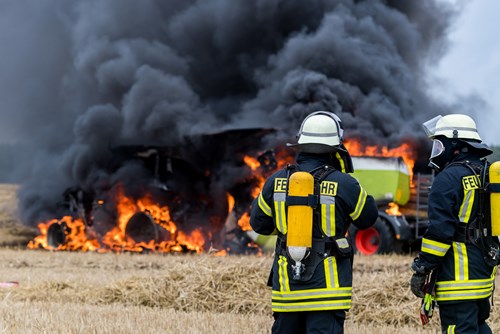The rising risks in agriculture
 Dafo Vehicles discusses how you can protect your machinery in the fields
Dafo Vehicles discusses how you can protect your machinery in the fieldsImproving your farm’s fire safety
Food availability is greatly influenced by the agriculture sector, but as margins become more constricted and demand rises, no farmer can afford extended downtime.
Increased risks
Since farming is not for the faint of heart, neither are the vehicles a farmer uses. Therefore, engines can typically overheat and catch fire in fields where machinery operates for extended periods of time with little rest.
Up to 11% of fires globally occur each year as a result of agricultural fires. Agricultural vehicles must now more than ever be protected from the risk of fire because farmers, like many other industries, are under pressure to produce more food while earning lower profits.
Due to the environment in which they operate, heavy vehicles, such as tractors, combine harvesters and other agricultural equipment, regularly face debris build-up from the material on the ground. One of the biggest reasons for vehicle fires on farms is improper maintenance. Maintaining cleanliness is essential because the accumulation of debris increases the amount of fuel that could catch fire and, in the event of a spark, will magnify the harm done to a farm or crop.
The effects
Due to the harsh weather brought on by climate change, even a small interruption of an essential machine at a critical time could have disastrous financial consequences. The majority of farms only have one combine harvester. Due to the precise timing needed for the harvest, even without the risk to workers and the cost of a new truck, a combine's downtime could result in the loss of an entire crop, negatively impacting the farm's worth.
Although insurance for combine harvesters is required, the cost of this defensive tactic can still significantly reduce your farm's annual income. As a result, it's crucial to prepare to put out fires before they get out of hand and to understand how you can make your vehicles more fire-resistant.

Understanding your farm
A fire risk assessment of your farm, not just of vehicles, is required before you can successfully secure your farm. This will help you pinpoint the specific location where a fire might start.
When creating your risk assessment, take into account:
- Sources
The sources of fuel, oxygen, and ignition. Consider where they are and how you may reduce them, such as removing hay and straw from fields as soon as possible after harvest and keeping them at least 10 metres away from any structures housing cattle.
For instance, many farmers are unaware that high-moisture hay bales are more likely to catch fire than dry ones because the moisture protects the bale, rising temperatures and increasing the likelihood of spontaneous combustion. It is crucial to take into account all potential sources of ignition on your farm.
- People and goods
What might increase the risk of a fire? Where are things that could burn and hurt people kept, and how do people move around them?
Consider performing an arson survey to identify the likely attack targets. Large automobiles can be a target for arson since they are infamous for being pricey, flammable and difficult to put out once a fire starts.
- Evaluate
To limit the potential harm that a fire might cause, think about fire safety measures like fire suppression systems. Remove or lessen these hazards while keeping in mind the risk of a fire beginning and the risk to people.
You can get the security you desire quickly and effectively with fire suppression systems. An autonomous system can function in challenging circumstances, like those long days on the farm, and swiftly spot and extinguish a fire.
With Dafo Vehicle, a fire is extinguished as soon as it starts by combining the four crucial components of detection, alarm, suppression, and control. A fixed linear heat detector cable that is activated at 180°C and an alarm system will sound to warn the driver of a fire, while the suppression system will release the Forrex liquid. This liquid agent will replace the oxygen before a hazardous fire fully starts, cooling down hot engine parts and avoiding reignition.
- Record, plan, instruct and train
Create an emergency plan with the assistance of the fire department, train the required staff, and document the findings of your risk assessment and the actions you take as a result.
Suppression systems need to include a clock and an event record so that they may look back on previous incidents, understand them, and prevent them from happening again.
Looking to the future…
It’s crucial that your vehicle is fully safeguarded because insurance companies currently mandate on-board fire suppression systems for combine harvesters. The fact that straw presses are among the smaller pieces of equipment exempt from these kinds of regulations does not mean they are risk-free, though.
When assessing the threat posed by your vehicles, take into account not just their specific components but also their entire purpose on your farm.
Farm safety must always come first as we look to the future and more and more electric or autonomous agriculture vehicles are deployed. Before they continue to increase as a result of new technological breakthroughs, we need to put a stop to the fire threats right away.
For more information on fire safety, get in touch here.
About Dafo Vehicle
Dafo was founded in 1919 and has developed into a modern, high-tech company committed to offer the very best solutions to its customers. Dafo was one of the first companies in the world which started to develop integrated firefighting solutions for vehicles back in 1976. Dafo Vehicle Fire Protection has three main business areas: Integration (Fire suppression systems integration into OEM production line, Retrofit (Fire suppression systems installed at final customer) as well as Service & Maintenance. The Dafo Vehicle group today consist of several subsidiaries and Dafo dealers – Dafo Vehicle Oy (Finland), Dafo US, Dafo Deutschland, Dafo Russia, Dafo Asia, Dafo Spain, Dafo UK & Ireland, Dafo Middle East, Dafo Chile, Dafo Brasil, Dafo Australia and Dafo Peru. The head office is located in Tyresö, Sweden.
Contacts

Åsa Westhammar
- asa.westhammar@dafo-vehicle.com
- +46 10 1768 186